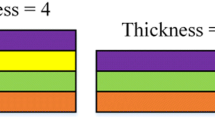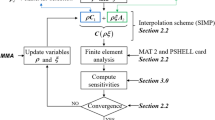Abstract
Due to its high reliability, composite material is commonly used in industry. Moreover, the stacking sequence is very crucial to the strength of the composite material. However, the arrangement of this sequence is very time-consuming. Actually, since stacking sequences are usually NP complete, simulated annealing (SA) algorithms were borrowed to deal with the stacking sequence problems in this study. The edging stress of a composite plate with constant thickness, which was obtained using an analytical method, was used as the objective function in the SA algorithms. Three examples of constant thickness and symmetrical composite laminate plates were used to examine the performance of the proposed algorithms. The results of computational tests presented are very promising.
Similar content being viewed by others
References
Pipes RB, Pagano NJ (1970) Interlaminar stresses in composite laminates under uniform axial extension. J Compos Mater 4:538–548
Pagano NJ, Pipes RB (1971) The influence of stacking sequence on laminate strength. J Compos Mater 5:50–57
Wang ASD, Crossman FW (1977) Some new results on the edge effect in symmetric composite materials. J Compos Mater 11:92–106
Kassapoglou C, Lagace PA (1986) An efficient method for the calculation of interlaminar stresses in composite materials. J Appl Mech 53:744–760
Tsai LR, Chang YH, Tsao FL (1995) The design of optimal stacking sequence for laminated FRP plates with inplane loading. Comput Struct 55(4):565–580
Tsai LR, Liu CH (1995) A comparison between two optimization methods on the stacking sequence of fiber-reinforced composite laminate. Comput Struct 55(3):515–525
Rybicki EF (1971) Approximation of three-dimensional solutions for symmetric laminates under in-plane loading. J Compos Mater 5:354–361
Metropolis N, Rosenbluth AW, Rosenbluth MN, Teller AH, Teller E (1953) Equations of state calculations by fast computing machines. J Chem Phys 21(6):1087–1092
Kirpatrick S, Gelatt CD, Veochi MP (1983) Optimization by simulated annealing. Science 220(4598):671–680
Lin S (1965) Computer solution of the traveling salesman problem. Bell Syst Tech J 44:2245–2269
Author information
Authors and Affiliations
Corresponding author
Rights and permissions
About this article
Cite this article
Deng, S., Pai, PF., Lai, CC. et al. A solution to the stacking sequence of a composite laminate plate with constant thickness using simulated annealing algorithms. Int J Adv Manuf Technol 26, 499–504 (2005). https://doi.org/10.1007/s00170-003-1909-2
Received:
Accepted:
Published:
Issue Date:
DOI: https://doi.org/10.1007/s00170-003-1909-2




